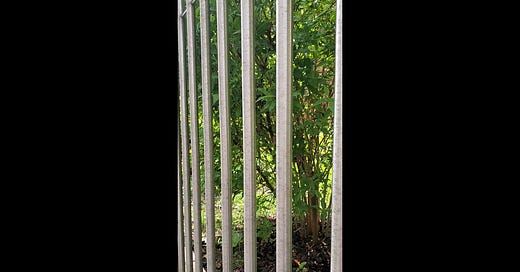This morning, I decided to let Dominik sleep in and walked by myself to the synagogue in Graz. It was a lovely walk; it’s chilly here today, and sunny between bouts of rain. To get to it, I had to go about a mile or so, and the walk took me through the Stadtpark, a bit of the old city, over the river, and along a street full of cafes and shops.
As you can see from the video, I was only able to see the synagogue from outside the metal fence that protects it, but I’d expected to have to stand outside some kind of barricade. While even in the US shuls and synagogues often ask visitors to present ID, here the precautions are more robust and, as in Salzburg, even the grounds around the building are inaccessible. Still, it exists, and that alone is no small thing.
If you’re an American Jew, you probably understand how the existence of this building—which is lovely and architecturally very interesting—tricked me into thinking there was a Jewish community in Graz large enough to support such a synagogue. It turns out that, instead, the state built and maintains the synagogue and the Jewish community organization. You can book a virtual tour of the building, attend services online (overseen by a rabbi in Vienna), or join one of the monthly in-person tours on their website, but to me, the place feels more like a memorial than a place of worship. Or maybe memorial is wrong, and perhaps it’s something more hopeful in the “if you build it, they will come” sort of way. Perhaps Graz would like more Jews to live here? After all, the university has a Center for Jewish Studies and everyone I’ve met here has been excited, rather than off-put, by my project to rediscover the stories of Jewish lives lived in parts of Europe where we once thrived.
So, since I can’t know either way, let’s go with hopeful.
On my way back to the AirBnB, I passed this couple. I was surprised to see that the man wore not just biker colors referencing Nazi iconography—American bikers also love their Nazi-sequel regalia—but an actual Reichsadler, an unmistakable symbol of Naziism. It’s illegal here to wear it (so of course it’s a pin that can be removed, instead of a permanent part of the club’s colors), and Dominik and the friend we met later for brunch were both also surprised.
So, I suppose we take some steps forward and some steps back, though how many of either I can’t say. The synagogue exists, but it does so behind steel bars. It’s illegal to wear Nazi symbols, and yet this man does so openly on the street with clearly little concern. (He didn’t even seem to notice that I was photographing him.)
Bigots have always, and will always, exist in every place. But I grew up in a time when admitting to one’s bigotry had serious social consequences. It seems we’re in a moment where holding people accountable for such things is seen as somehow “cancelling” them, and both here and at home more and more people are comfortable openly advocating for bigoted and racist ideologies.
Let’s hope the pendulum swings back to better times soon, my friends.






Share this post